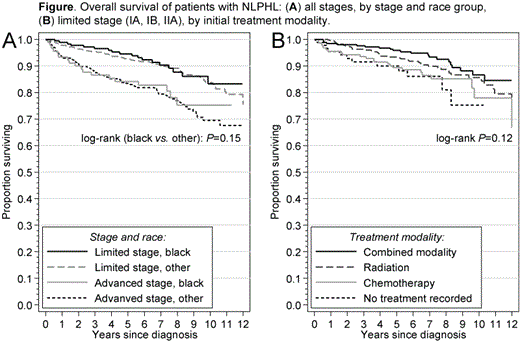Abstract
Background: NLPHL is a rare, biologically distinct subtype of Hodgkin lymphoma (HL) characterized by late recurrences and risk of transformation to non-Hodgkin histology. The incidence of NLPHL is markedly increased among black patients (pts), but they were not distinguished in prior studies, and data are lacking about specific features in this group. Relative benefits of various treatment modalities in early-stage NLPHL are also controversial. Radiation therapy (RT) is endorsed by guidelines, but one large study suggested a survival advantage of combined modality therapy (CMT) over historical controls treated with RT alone (Savage et al., Blood 2011:118:4585). The objective of this study was to compare clinical features of NLPHL in black and other pts, and to describe treatment patterns and survival using the National Cancer Data Basea registry capturing over 70% of incident cancers in the United States (US).
Methods: We identified NLPHL and classical HL cases diagnosed between 1998 and 2011, with survival data available for the 1998-2006 cohort. Receipt of chemotherapy (ChT), RT or CMT as initial course of treatment was recorded. Stage was categorized as limited (Ann Arbor I, IIA) or advanced (IIB, III, IV). Overall survival (OS) was the primary outcome and was compared using log-rank tests stratified by stage, sex and age group. Trends were assessed using log-linear regression. All confidence intervals (CI) were set at 95%.
Results: Among the NLPHL pts (N=2,656), 23% were of black race (N=602), compared with 10% of classical HL cases (N=66,369). Most NLPHL pts presented with limited stage disease (66%), without any difference between races (P=0.79). Stage migration was evident between 1998 and 2003 with the proportion of stage III/IV cases increasing by 13.2% per year (CI, 3.3-24.0, P=0.008). The male-to-female ratio was 1.0 (CI, 0.9-1.2) in black pts, whereas pronounced male predominance was present in others (ratio 2.5, CI, 2.2-2.7). Black pts were also on average younger (median age 42 years, versus 45 for others, P=0.0001), and their NLPHL more often originated from the axillary nodes (25%, versus 17% for other races, P=0.0003).
Median follow-up was 7.1 years. OS at 7 years was 90.1% (CI, 87.7-92.1) for limited- and 80.1% (CI, 75.6-83.8) for advanced-stage NLPHL, with no difference between the races (P=0.15, Fig. A). In limited disease, RT alone was used in 55%, 31% and 27% of pts with stage IA, IB and IIA, respectively, while CMT was used in 21%, 33% and 35%, and ChT alone in 12%, 24% and 31%, respectively. Black pts were more likely to have no treatment recorded (P<0.0001), but the proportions of various modalities was otherwise the same (P=0.76). The difference in OS between the treatments was not significant, with 7-year OS of 93.3% (CI, 88.8-96.1) after CMT, 90.0% (CI, 85.7-92.9) after RT, and 86.5% (CI, 79.5-91.2) after ChT alone (P=0.12, Fig. B). There was a significant trend towards decreased utilization of RT over time (on average by 1.6% per year, P=0.0002).
In advanced NLPHL, 71% of patients were treated with ChT alone, 15% with CMT, 3% with RT alone and 11% had no recorded treatment. A significant trend towards less RT was again evident (8.9% per year, P<0.0001).
Conclusions: The specific gender, age and primary site distribution in black pts with NLPHL suggests an inherited susceptibility, possibly mediated by immune or endocrine factors. Survival outcomes are not different from other races. In early-stage NLPHL, various treatment modalities are not associated with significant OS differences, although survival is numerically highest with CMT. Because of stage migration coinciding with the introduction of positron emission tomography, stage-based survival comparisons with cohorts from 1990's may be biased.
No relevant conflicts of interest to declare.
Author notes
Asterisk with author names denotes non-ASH members.


This feature is available to Subscribers Only
Sign In or Create an Account Close Modal